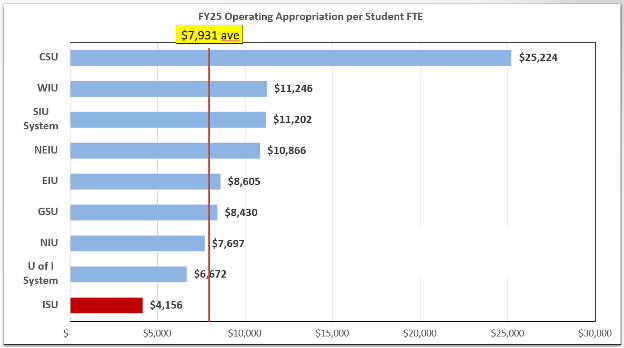Budget Challenges
Illinois State has had a healthy financial outlook for many years. Certain challenges we face require us to rethink how we budget and allocate funds. Many universities are changing how they allocate resources to improve predictability and increase alignment between financial decision-making and strategic priorities.
Rising Expenses
Illinois State is part of a national and global ecosystem subject to the same pressures facing the entire higher education sector. Colleges and universities are under severe pressure on many fronts regionally, nationally, and internationally.
Expenses are outpacing revenues at many small, midsize, and even large public and private universities. The cost of delivering a high-quality education continues to rise.
Technological advances, facility enhancements, and the necessity for competitive compensation to attract and retain talented employees have all escalated operational expenses, as has the impact of inflation on everything from office supplies to utilities and construction costs.
Enrollment Cliff
The traditional college-age population is shrinking, especially in the Midwest and Northeast, increasing competition among institutions for a smaller pool of prospective students.
Enrollments have been declining nationally for several years, and a steep decline is projected to hit colleges and universities in 2026 due to fewer students graduating from high schools.
Nevertheless, Illinois State has remained a school of choice for students, as evidenced by our continued strong enrollment. To maintain strong enrollments in the face of increased competition for fewer students, ISU must continue developing programs that serve community needs and appeal to prospective students while at the same time strengthening our academic profile.
While the University has been strategic in its enrollment growth, we must also plan for this growth to slow or even decrease in response to declining numbers of high school graduates in Illinois.
Revenue
Illinois State has had strong enrollment over the years. While higher enrollments do provide additional revenue, it is not enough to cover projected cost increases in the general fund. Additionally, the historic funding formula for state appropriations is not tied to enrollment.
Universities utilize different fund sources in their operations. General revenue funds from tuition and state appropriations are considered unrestricted in their use. These funds provide the vast majority of faculty and staff wages, salaries, and expenditures. Other funds – AFS/bond, private gift support, and grant funds – are considered restricted in their use. Restricted funds are not interchangeable with unrestricted funds.
Learn more about University funds
State Funding
ISU’s FY2025 state appropriation of $79.8 million accounts for less than 14% of the University’s total budget compared to 35% in FY2002 when our appropriation was $92.3 million. Further, after adjusting for inflation, our FY2025 appropriation equates to a purchasing power of $45 million compared to FY2002 funding levels.
Compared to other public institutions in Illinois, Illinois State remains the lowest funded university per-student FTE despite years of advocacy with the state about this imbalance. We have been able to weather this funding structure until now, but rising costs mean this is no longer sustainable.

This Commission on Equitable Public University Funding was created by PA 102-0570 to recommend “specific data-driven criteria and approaches to the General Assembly to adequately, equitably, and stably fund public universities in this State and to evaluate existing funding methods.” The Illinois Commission on Equitable University Funding found that to fully fund higher education the state would need to invest an additional $1.4 billion over the next 10-15 years. While discussions at the state level are ongoing, there is no guarantee that this investment will materialize.
Unfunded State Mandates
Unfunded mandates are state statutes or regulations that require universities to perform certain actions without providing additional financial assistance to cover the expense.
Unfunded mandates cost the University millions of dollars each year. State-mandated waivers alone cost the University more than $12 million annually in foregone tuition and fee revenue.
| Total Awarded | Total Funded | Unfunded Mandate | |
|---|---|---|---|
| Teacher Special Education | $5,767,000 | $5,767,000 | |
| Veterans Grants and Scholarships* | $3,845,000 | $518,900 | $3,326,600 |
| Children of Employees | $2,040,400 | $2,040,400 | |
| ROTC | $510,700 | $510,700 | |
| DCFS | $868,400 | $868,400 | |
| Total | $13,032,000 | $518,900 | $12,513,100 |
*For veterans grants: Illinois Veterans Grants, Illinois National Guard, and MIA/POW grants, partial founding received only received for Fall 2023 semester for MIA/POW grant.
Addressing Budget Challenges
The long-term challenging budget trends are not new information to the University. Here are a few action steps we’ve taken to address challenges.
RISE Initiative Questions
We want to hear your questions related to the RISE initiative.